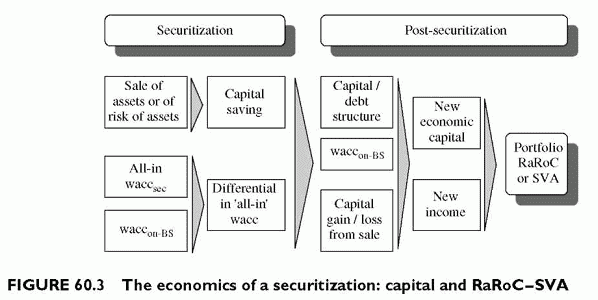THE ECONOMICS OF SECURITIZATION
Category: Risk Management in Banking
The issue, when off-loading risks, is whether freeing up capital in this way is economically acceptable. The solution lies in finding out whether this makes the risk-return profile of the banking portfolio more efficient (higher return for the same risk or lower risk for the same return). When using the portfolio Sharpe ratio as the target variable, the issue is to find out whether the securitization improves the banks portfolio Risk-adjusted Return on Capital (RaRoC) or not.
Through structuring of notes, securitization dissociates the quality of the original flows from the quality of the promise of flows to investors. As a result, funding through securitization has a cost that has no reason to coincide with the cost of funding on-balance sheet for the seller. The cost through securitization combines operating costs plus the cost of funding in the market through the notes. Whether on-balance sheet or in the market, the weighted average cost of funds summarizes the cost of various funding solutions. It is the weighted average of costs of equity and debt in the banks balance sheet, and the weighted average of the costs of the various notes issued by the securitization. In both cases, we use the familiar weighted average cost of capital (wacc). The next question is to compare the wacc on-balance sheet (waccon-BS) with the wacc of securitization (waccsec), inclusive of operating costs. Intuition suggests that if the waccsec is below the waccon-BS, the economics of the securitization are favourable, and conversely.
Analysing the economics needs identifies all critical parameters underlying such differences, quantifying the gap between the costs of funding on- or off-balance sheet and the effect on capital and return on capital. Since the securitization triggers savings of capital plus a differential cost of funds, it could well be that capital savings suffice to improve the return on capital (RaRoC or Sharpe ratio of the portfolio remaining with the seller), even though the differential cost of funding is not favourable. This depends on the relative magnitude of the change in net income due to volume and capital gains or losses when selling the assets to the SPV, and on capital savings.
The first securitizations arbitraged the regulatory capital, using the favourable forfeits accepted by regulators for the equity tranche. The capital charge for this tranche was limited, without checking that it could actually cover unexpected losses that might materialize. The regulators increased the capital charges for such credit enhancement tranches, as well as for subordinated notes, by differentiating capital according to ratings. In any case, the true economics of the securitization necessitate developing the analysis on economic capital rather than regulatory capital.
Figure 60.3 summarizes the process of analysing the economics of a securitization for the seller of assets. The figure applies both for classical cash securitization as well as for synthetic securitization aimed at saving capital, because the end result is the same.
Costs and Benefits of Securitization
The potential benefits of securitization are:
• Reducing the cost of funding the assets by going through the market. This is an arbitrage between the cost of funding on and off the sellers balance sheet.
• Saving capital through the non-recourse transfer of credit risk to the SPV, both in classical cash securitizations and synthetic CLOs. These are sometimes called balance sheet securitizations, since they arbitrage the capital load required on and off the balance sheet.
• Optimizing the portfolio risk-return profile, by restructuring the on-balance sheet portfolio and increasing the Sharpe ratio of the portfolio or, in general, moving towards the efficient frontier.
It is not always feasible to meet such goals, because the economics of the transaction have to comply with market conditions. For instance, selling low-yield assets to a fund when high market yields prevail, generating capital losses, so that the yields of notes are in line with the market, thereby destroying value. Still, the securitization would reduce capital, but at an unacceptably high cost. Several parameters influence the economics of the securitization for the seller of assets:
• The risk and return of original assets. They depend on the sellers choice in interaction with the rating agency, which might consider that only some assets are eligible for the project.
• The market credit spreads across rating classes. These are market-driven.
• The potential savings in economic and/or regulatory capital. These depend on the portfolio risk profile of the securitized assets and on their risk contribution to the sellers (banks) portfolio. Full assessment of the economic capital savings requires running the portfolio model with and without the securitized assets to get their marginal risk contribution to capital. The assessment of the regulatory capital savings is much quicker since it uses forfeits.
• The structuring of the transaction determines the pool composition as well as the profile of the structured notes issued. The first influences capital savings directly. The second influences the cost of funding through securitization directly.
• The costs of creating the structure, of operating the SPV and of servicing the assets. These increase the all-inclusive cost of funding through securitization since they add up to the wacc of issued notes.
Analysing the economics of the transaction requires reviewing all costs and benefits resulting from the specific values of each of these parameters at the time of the transaction.

